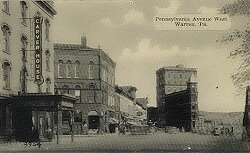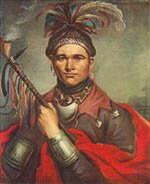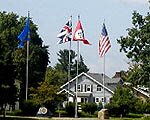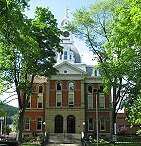 |

Life in Warren County > Heritage
|

It all began in 1795. Andrew Ellicott and General William Irvine were appointed by the government to survey and lay out the town of Warren. Warren County was carved from Lycoming and Allegheny Counties and named after General Joseph Warren, who was a hero at the famous Revolutionary Battle of Bunker Hill (Breeds Hill). It became a full-fledged county in 1819 with the establishment of the county seat at Warren.
|
Warren County Historical Society
 The Warren County Historical Society (WCHS) - also the Warren Historic District Information Center - holds the collection of our timeless past. With a large collection of genealogical records, newspaper clippings, notebooks, scrapbooks, and yearbooks, the Historical Society holds thehistory of the people of Warren County. Material and information on surrounding areas is also available. The Society is housed in the The Warren County Historical Society (WCHS) - also the Warren Historic District Information Center - holds the collection of our timeless past. With a large collection of genealogical records, newspaper clippings, notebooks, scrapbooks, and yearbooks, the Historical Society holds thehistory of the people of Warren County. Material and information on surrounding areas is also available. The Society is housed in the  Struthers-Wetmore-Schimmelfeng House in which it displays exhibits on county history. Fourteen additional local history exhibit rooms have been established in the Wilder Museum of Irvine, an off-site property of the Warren County Historical Society. Struthers-Wetmore-Schimmelfeng House in which it displays exhibits on county history. Fourteen additional local history exhibit rooms have been established in the Wilder Museum of Irvine, an off-site property of the Warren County Historical Society.
|
Celeron's Lead Plates
In 1749, Frenchman Celoron de Blainville made his way to and through Warren County via Conewango Creek and the Allegheny River. The territory had already been claimed for France by explorer La Salle, and Celoron reinforced that claim by burying lead plates at strategic locations. Although four of these plates placed during his exploration have been discovered, the plate for Warren has never been found.
Chief Cornplanter
 During the early settlement of the whites, the Native Americans of the Seneca Nation still inhabited the region, and trade relations were set up. Under the command of Chief Cornplanter, the Seneca Indians fought with the British during the American Revolution. Cornplanter realized the value of aligning with the newcomers to maintain peace for his people. He was given a plot of land for his successors to live on, known as Cornplanter Grant, in Corydon and Kinzua Townships. The area is now under the waters of the U.S. Army Corps of Engineers Allegheny Reservoir. The Seneca Indian cemetery, home to Cornplanters grave, taken by eminent domain in 1964, was moved to higher ground just across the border in New York State. The Cornplanter Grant was the last of the occupied Indian lands in the state. During the early settlement of the whites, the Native Americans of the Seneca Nation still inhabited the region, and trade relations were set up. Under the command of Chief Cornplanter, the Seneca Indians fought with the British during the American Revolution. Cornplanter realized the value of aligning with the newcomers to maintain peace for his people. He was given a plot of land for his successors to live on, known as Cornplanter Grant, in Corydon and Kinzua Townships. The area is now under the waters of the U.S. Army Corps of Engineers Allegheny Reservoir. The Seneca Indian cemetery, home to Cornplanters grave, taken by eminent domain in 1964, was moved to higher ground just across the border in New York State. The Cornplanter Grant was the last of the occupied Indian lands in the state.
Lumber and Oil
 The earliest settlers to Warren County came with the dawn of the 19th century. Due to its location at the confluence of the Allegheny River and Conewango Creek, Warren was an obviously prime area for settlement. The lumber industry boomed. Men constructed wooden rafts to ride on as they directed lumber down the Allegheny to Pittsburgh. They would often return to Warren on foot by following a path along the river. Tanneries also sprang up. The Sheffield area was home to many. In the mid 1800s, oil was discovered, with Tidioute having particularly rich deposits. By 1900, oil had become a major industry in Warren County. At one point, there were thirteen active oil refineries within a six-mile radius of Warren. Even though locally it is not as large an industry today, oil still plays a substantial role in our economy. The earliest settlers to Warren County came with the dawn of the 19th century. Due to its location at the confluence of the Allegheny River and Conewango Creek, Warren was an obviously prime area for settlement. The lumber industry boomed. Men constructed wooden rafts to ride on as they directed lumber down the Allegheny to Pittsburgh. They would often return to Warren on foot by following a path along the river. Tanneries also sprang up. The Sheffield area was home to many. In the mid 1800s, oil was discovered, with Tidioute having particularly rich deposits. By 1900, oil had become a major industry in Warren County. At one point, there were thirteen active oil refineries within a six-mile radius of Warren. Even though locally it is not as large an industry today, oil still plays a substantial role in our economy.
Underground Railroad
The Sugar Grove area was a stop on the Underground Railroad that took slaves from below the Confederate border all the way to Canada. Escapees would often stay and work in Sugar Grove to make enough money to continue their journey. Sugar Grove was considered a safe haven from slave bounty hunters. Among the buildings that were a part of the Sugar Grove Underground Railroad is the First Presbyterian Church, the oldest religious facility in Warren County still in use. Many famous abolitionists came to the region, including Frederick Douglass and J.W. Loguen, both of whom spoke at the 1854 Anti-Slavery Convention in Sugar Grove. Sallie Holley, a lecturer for the American Anti-Slavery Society, also visited to speak against slavery in 1858.
Visit the Sugar Grove Underground RR website
|
|
|
 |
|
 |
 |

The first building constructed in Warren was a log storehouse owned by the Holland Land Company. It was erected in 1795 and stood until 1840. |
 |
| |
 |
 |

Revoultionary War hero General Joseph Warren never set foot in Warren County. |
 |
| |
 |
 |


Chief Cornplanter was known by Indians and non-Indians alike for his intelligence and abilities as a spokesperson. He was the son of a Seneca woman and a Dutch father.
|
 |
| |
 |
 |

The second oil well in the world was drilled at Tidioute, Warren County in 1860. The first was drilled in Titusville in 1859. |
 |
| |
 |
 |

Lewis G. Clarke, famous abolitionist author and orator, lived in Sugar Grove before moving across the New York border to Busti. He was the inspiration for character George Harris in Harriet Beecher Stowes novel, Uncle Toms Cabin. |
 |
| |
 |
 |

Blair Corporation, originally called New Process Company, was founded in Warren in 1910. Its original name is derived from a new process used to vulcanize fabric so that undertakers could wear black raincoats that wouldnt bleed in the rain. |
 |
| |
|
| |
|


